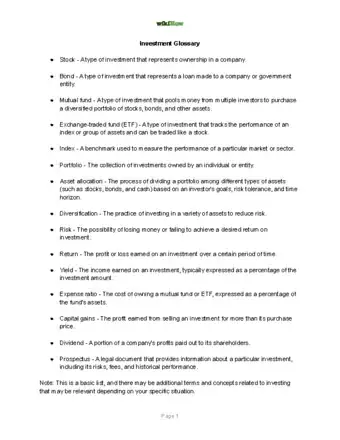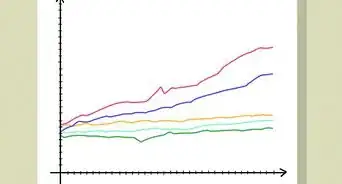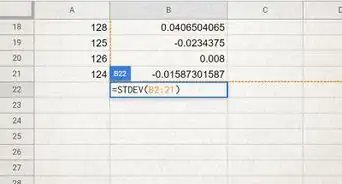This article was co-authored by Ara Oghoorian, CPA. Ara Oghoorian is a Certified Financial Accountant (CFA), Certified Financial Planner (CFP), a Certified Public Accountant (CPA), and the Founder of ACap Advisors & Accountants, a boutique wealth management and full-service accounting firm based in Los Angeles, California. With over 26 years of experience in the financial industry, Ara founded ACap Asset Management in 2009. He has previously worked with the Federal Reserve Bank of San Francisco, the U.S. Department of the Treasury, and the Ministry of Finance and Economy in the Republic of Armenia. Ara has a BS in Accounting and Finance from San Francisco State University, is a Commissioned Bank Examiner through the Federal Reserve Board of Governors, holds the Chartered Financial Analyst designation, is a Certified Financial Planner™ practitioner, has a Certified Public Accountant license, is an Enrolled Agent, and holds the Series 65 license.
There are 9 references cited in this article, which can be found at the bottom of the page.
wikiHow marks an article as reader-approved once it receives enough positive feedback. This article received 32 testimonials and 100% of readers who voted found it helpful, earning it our reader-approved status.
This article has been viewed 4,044,340 times.
When you buy stock, you are purchasing ownership in the company that issues the security. As an owner, you have certain rights. For example, a stock investor has the right to receive a dividend if the company generates sufficient earnings. Investors also have the potential to sell their shares of stock for a gain. You can buy individual shares of stock, or purchase a stock mutual fund.
Steps
Learning About The Stock Market
-
1Consider how the stock market works. The stock market works like any other marketplace. In this case, the products being bought and sold are pieces of ownership in companies. We call these shares of stock. Stocks are traded on exchanges. You can think of an exchange as the marketplace. In the U.S., the major exchanges include the New York Stock Exchange and the National Association of Securities Dealers Automated Quotation system (the NASDAQ).[1]
- Stock prices move up and down depending on supply and demand. When there is a large demand for a stock, its price will rise. Since there are more interested buyers than sellers, the stock price will increase. When there are more sellers than buyers, the price will fall.
- A stock's price is a reflection of the investment community’s opinion of the stock. The price is not necessarily the actual value of the company. This means that short-term prices are often affected by people's emotions, rather than by facts. Prices can move based on information, misinformation, and rumor.
- Your goal as a stock investor is to purchase shares of a company that will increase in value over time. If the issuing company grows their sales and increases profits, investors may buy more of the stock. If the stock price goes up, you can sell your shares for a gain.
- For example, imagine that you buy 100 shares of stock priced at $15 each. That's a $1,500 investment. After two years, the stock price increases to $20. Now, your investment is worth $2,000. If you sell your shares, you’ll recognize a $500 gain before any fees or commissions ($2,000 - $1,500).
-
2Go over the terminology related to stock trading. These terms help you decide exactly what type of buy or sell order you want to place with your broker. The terms allow you place certain conditions on your order to buy or sell stock.[2]
- The ask price, also known as the offer, is the lowest available price when trying to buy shares of a stock. Assume you want to buy IBM common stock. If the current ask price is $50 per share, you would pay the $50 price for the stock.
- The bid price (or simply bid) is the highest available price you can find when trying to sell shares of a stock. If you own IBM common stock and want to sell it now, you would receive the bid price per share. If the bid price is $49.75, you would receive that price per share.
- A market order is a request to buy or sell a security immediately at the best price available. If you place a market order, you will pay the ask price as a buyer. If you are selling, the market price you receive will be the current bid price. Keep in mind that your order could be executed at a price higher or lower than what you're hoping for. The immediate execution of a market order is guaranteed but the price is not.
- In addition to a market order, you can place orders that put conditions on your buy or sell price. A limit order, for example, is a request to buy or sell a security at a specific price or better. On the other hand, a stop order is an order that becomes a market order once a certain price is reached. Consult with a broker who is licensed to trade securities. Ask the broker if these other types of orders are right for you.
Advertisement -
3Look into buying a mutual fund. A mutual fund is a pool of money provided by many investors. The pool can be used to buy a variety of investments. You can select a mutual fund that invests in the stocks of many different companies. When you invest through a mutual fund, you get a stake in every stock the fund invests in. This can be a lower-risk alternative to buying stocks individually.[3]
- Investing in mutual funds can lower your investment risk because of diversification. If you invest in one stock, your risk is concentrated in one company. A mutual fund, on the other hand, may hold dozens (even hundreds) of stocks. If the value of one stock declines, it will have little effect on the overall value of your investment.
- If you’re just starting out as an investor, this can be a good way to invest in stocks. Choose a mutual fund if you feel uncertain about investing in stocks individually, or if you don't have sufficient time to research and manage a portfolio.
- Be aware of mutual fund fees. Keep in mind that you will pay fees for professional money management in a mutual fund. For example, you may pay a sales charge when you buy or sell your fund. Fund investors will also pay an annual fee for the money management and operation of the fund. These annual fees are based on a percentage of the assets under management.
- Say, for example, that you have $10,000 invested in a stock mutual fund. If the annual fee is 1/2 of 1% of the assets, you annual fee will be $50.
Researching A Stock Purchase
-
1Learn about investment research. If you decide to purchase individual stocks instead of a mutual fund, it is important to do some research. There is a huge amount of available data on the Internet. Finding useful data can be difficult. There are some useful tools you can use to perform analysis and select a stock.[4]
- Information about stocks is typically found on a company's website or in their annual report. These resources can provide valuable information about a company's business model and financial results. In addition, companies frequently prepare investor presentations. These presentations are often provided in an easy-to-understand format. Review these documents before making an investment decision.
- Websites like Morningstar.com are also useful. New investors may find quarterly or annual reports overwhelming. By researching a stock on Morningstar, you can access essential information on a company, such as the balance sheet, income statement, and statement of cash flows. Morningstar also provides important financial ratios, which help in analyzing the company. This website is easy to navigate and review.
- Perform a Google search for news about the company. Read the recent news articles that explain how the company is performing. A news source should be an independent third party, so the information should not be biased.
-
2Search for companies of interest. The first step is to find a company to research. To do this, read investing publications and websites, like the Wall Street Journal or Investor's Business Daily. Similarly, websites like Stockchase.com can provide ideas for stocks that analysts rank highly.
- Start by investing in blue chip stocks. Blue chip stocks are large, well-established companies with a track record of generating profits. These firms are typically recognizable corporate names. They make products and services that consumers know and purchase. These stocks are more likely to grow steadily in price over the long-term.
- While these companies do present some risk to the investor, they are often less volatile than other companies. Blue chips tend to have a large market share in the markets they operate. These firms are well funded, and may enjoy some competitive advantage.
- Blue chip stocks include Walmart, Google, Apple, and McDonald's, among many others. Think about companies that you turn to for products and services.
-
3Choose a business that performs well. Once you find a good candidate, you should review some key financial indicators for the company. Compare those indicators with the firm’s competitors to see how they compare. A few specific indicators are widely used to assess the investment value of a company.
- Look at the company's profit margin. Profit margin is defined as (net income)/ (sales). For this discussion, net income and profit mean the same thing. This indicator explains how much profit a firm generates for every dollar in sales. A business always wants a higher profit margin. If a firm earned 10 cents on every dollar sold, for example, the profit margin would be (.10)/ ($1), or 10%.
- Analyze the company's return on equity. Equity refers to the total dollars invested by all company stockholders. Return on equity shows how well a company is using its shareholders' money to generate a profit. The ratio is stated as (profit) / (shareholder equity). If a firm earned $100,000 profit on $2,000,000 in equity, the return on equity would be ($100,000)/($2,000,000), or 5%.
- Look at a company's past and expected growth. Is the company steadily growing earnings per share? This is a sign of a strong business that likely has a competitive advantage of some sort.
- Compare the firm’s historic rate of earnings growth to its peers. Also, look at the projected earnings growth rate for the next five years. If it is higher than its peers, that’s an indication that the stock price may increase.
- Look at the company's debt. A well-managed company should not take on more debt than it can afford to repay. One popular way to analyze debt is using the debt-to-equity ratio.
- The debt-to-equity ratio takes the company's debt and divides it by shareholder equity. The lower the percentage is, the better. If a firm has $2,000,000 in debt and $4,000,000 in equity, the debt-to-equity ratio would be ($2,000,000)/($4,000,000), or 50%. Compare the ratio to the firm’s competitors.
-
4Familiarize yourself with the concept of value. You can think of a stock as a machine that is designed to generate profits. If the machine performs well and is able to generate more profit, investors view the machine as more valuable. The most important financial ratios for a stock’s value relate to earnings.[5]
- The common way to value a stock is to use the price-to-earnings (P/E) ratio. The P/E ratio takes a company's current share price and divides it by the annual earnings (profits) per share of stock. This is an important tool to evaluate the value of an investment.
- Earnings per share represents the total earnings in dollars divided by the number of shares held by the investing public. Shares held by investors are referred to as outstanding shares. If, for example, a company earns $1,000,000 per year and has 10,000,000 shares outstanding, the earnings per share is ($1,000,000) / (10,000,000 shares), or 10 cents per share.
- Assume that a company’s stock is trading at $50 per share. If the earnings-per-share total $5, the stock’s P/E ratio is ($50/$5), or 10. If an investor bought this particular stock, they would be “paying 10 times earnings”.
- If Company A is trading at ten times earnings (or a P/E of 10), and Company B is trading at a P/E of 8, Company A is more expensive. Note that "more expensive" has nothing to do with the share price. Instead, the multiple is a reflection of how expensive the share price is relative to earnings.
Making Your Investment
-
1Investigate the possibility of buying stock directly from the issuer. Some companies offer direct stock purchase plans (DSPPs) that allow you to purchase stock without using a broker. If you are planning to buy a small amount of a certain stock, this may be your best option. This approach saves you the time and cost of going through a broker.[6]
- Search online or call the company whose stock you wish to buy. Ask them if they offer a stock purchase plan. If they do, the firm will forward you a copy of their plan's prospectus, application forms, and other relevant information. A prospectus is a regulatory document that discloses all of the important information about a stock purchase.
- Many plans allow you to invest as little as $50 per month. Verify any fees you need to pay. A few companies offer no-fee investment plans.
- DSPPs also allow you to reinvest all your dividends automatically if you desire. Dividends are paid to you based on the profits of the company. The company’s board of directors must declare a dividend in order for a payment to take place.
-
2Choose a broker. If you can't buy the stock you want directly from the issuing company, you'll need to find a broker. Brokerage houses vary in terms of the services they provide. This means you'll need to compare your options and choose the brokerage that suits you best. Generally speaking, there are two types of brokers: full-service and discount.[7]
- Full-service brokers are more expensive. These firms target their services toward investors interested in receiving recommendations and guidance. The higher fee may be worthwhile, however, because full-service brokers can provide valuable assistance. If you’re not confident in your ability to pick stocks, or if you don’t have time, consider working with a full-service broker.
- If you plan to make your own investment decisions, choose a discount broker. There is no point in paying a higher fee for services you aren't going to use. Still, you must examine each broker's platform closely to make sure their offerings align with your investment objectives.
- Search the Internet for online discount brokers. Analyze the fees, particularly any additional charges that may not be mentioned when you first contact a prospective broker. Ask for a written disclosure of all fees charged.
-
3Open a brokerage account and deposit funds. Contact a broker about opening an account. Your broker will have you fill out a new account form. This form documents your personal information, along with your investment experience and your risk tolerance.[8]
- Your broker must report your stock trades to the IRS. Specifically, sales proceeds from a stock sale, along with dividend income, are reported to the IRS. You will need to fill out the required forms and send them back to the broker.
- Determine how to deposit funds into your brokerage account. Send your broker an initial deposit of money that will be used to make your first stock purchase.
- Enter an order. Notify your broker of the company's stock you want to buy and the number of shares. When your trade is completed, you will receive a confirmation. The confirmation is your record of the purchase. Keep all of your confirmations on file.
Investment Glossary
Expert Q&A
Did you know you can get expert answers for this article?
Unlock expert answers by supporting wikiHow
-
QuestionWhat are common mistakes when starting to invest?
 Ara Oghoorian, CPAAra Oghoorian is a Certified Financial Accountant (CFA), Certified Financial Planner (CFP), a Certified Public Accountant (CPA), and the Founder of ACap Advisors & Accountants, a boutique wealth management and full-service accounting firm based in Los Angeles, California. With over 26 years of experience in the financial industry, Ara founded ACap Asset Management in 2009. He has previously worked with the Federal Reserve Bank of San Francisco, the U.S. Department of the Treasury, and the Ministry of Finance and Economy in the Republic of Armenia. Ara has a BS in Accounting and Finance from San Francisco State University, is a Commissioned Bank Examiner through the Federal Reserve Board of Governors, holds the Chartered Financial Analyst designation, is a Certified Financial Planner™ practitioner, has a Certified Public Accountant license, is an Enrolled Agent, and holds the Series 65 license.
Ara Oghoorian, CPAAra Oghoorian is a Certified Financial Accountant (CFA), Certified Financial Planner (CFP), a Certified Public Accountant (CPA), and the Founder of ACap Advisors & Accountants, a boutique wealth management and full-service accounting firm based in Los Angeles, California. With over 26 years of experience in the financial industry, Ara founded ACap Asset Management in 2009. He has previously worked with the Federal Reserve Bank of San Francisco, the U.S. Department of the Treasury, and the Ministry of Finance and Economy in the Republic of Armenia. Ara has a BS in Accounting and Finance from San Francisco State University, is a Commissioned Bank Examiner through the Federal Reserve Board of Governors, holds the Chartered Financial Analyst designation, is a Certified Financial Planner™ practitioner, has a Certified Public Accountant license, is an Enrolled Agent, and holds the Series 65 license.
Certified Financial Planner & Accountant
-
QuestionHow do beginners buy stocks?
 Ara Oghoorian, CPAAra Oghoorian is a Certified Financial Accountant (CFA), Certified Financial Planner (CFP), a Certified Public Accountant (CPA), and the Founder of ACap Advisors & Accountants, a boutique wealth management and full-service accounting firm based in Los Angeles, California. With over 26 years of experience in the financial industry, Ara founded ACap Asset Management in 2009. He has previously worked with the Federal Reserve Bank of San Francisco, the U.S. Department of the Treasury, and the Ministry of Finance and Economy in the Republic of Armenia. Ara has a BS in Accounting and Finance from San Francisco State University, is a Commissioned Bank Examiner through the Federal Reserve Board of Governors, holds the Chartered Financial Analyst designation, is a Certified Financial Planner™ practitioner, has a Certified Public Accountant license, is an Enrolled Agent, and holds the Series 65 license.
Ara Oghoorian, CPAAra Oghoorian is a Certified Financial Accountant (CFA), Certified Financial Planner (CFP), a Certified Public Accountant (CPA), and the Founder of ACap Advisors & Accountants, a boutique wealth management and full-service accounting firm based in Los Angeles, California. With over 26 years of experience in the financial industry, Ara founded ACap Asset Management in 2009. He has previously worked with the Federal Reserve Bank of San Francisco, the U.S. Department of the Treasury, and the Ministry of Finance and Economy in the Republic of Armenia. Ara has a BS in Accounting and Finance from San Francisco State University, is a Commissioned Bank Examiner through the Federal Reserve Board of Governors, holds the Chartered Financial Analyst designation, is a Certified Financial Planner™ practitioner, has a Certified Public Accountant license, is an Enrolled Agent, and holds the Series 65 license.
Certified Financial Planner & Accountant Think about what your risk tolerance is before jumping into the investing world. How much money are you willing to lose in the short-term with the potential of making it back in the long-term? In general, keep in mind that the stock market is volatile in the short-term. In the long-term, it continues to go up as the economy and society grow.
Think about what your risk tolerance is before jumping into the investing world. How much money are you willing to lose in the short-term with the potential of making it back in the long-term? In general, keep in mind that the stock market is volatile in the short-term. In the long-term, it continues to go up as the economy and society grow. -
QuestionWhat are some common mistakes people make when they start investing?
 Ara Oghoorian, CPAAra Oghoorian is a Certified Financial Accountant (CFA), Certified Financial Planner (CFP), a Certified Public Accountant (CPA), and the Founder of ACap Advisors & Accountants, a boutique wealth management and full-service accounting firm based in Los Angeles, California. With over 26 years of experience in the financial industry, Ara founded ACap Asset Management in 2009. He has previously worked with the Federal Reserve Bank of San Francisco, the U.S. Department of the Treasury, and the Ministry of Finance and Economy in the Republic of Armenia. Ara has a BS in Accounting and Finance from San Francisco State University, is a Commissioned Bank Examiner through the Federal Reserve Board of Governors, holds the Chartered Financial Analyst designation, is a Certified Financial Planner™ practitioner, has a Certified Public Accountant license, is an Enrolled Agent, and holds the Series 65 license.
Ara Oghoorian, CPAAra Oghoorian is a Certified Financial Accountant (CFA), Certified Financial Planner (CFP), a Certified Public Accountant (CPA), and the Founder of ACap Advisors & Accountants, a boutique wealth management and full-service accounting firm based in Los Angeles, California. With over 26 years of experience in the financial industry, Ara founded ACap Asset Management in 2009. He has previously worked with the Federal Reserve Bank of San Francisco, the U.S. Department of the Treasury, and the Ministry of Finance and Economy in the Republic of Armenia. Ara has a BS in Accounting and Finance from San Francisco State University, is a Commissioned Bank Examiner through the Federal Reserve Board of Governors, holds the Chartered Financial Analyst designation, is a Certified Financial Planner™ practitioner, has a Certified Public Accountant license, is an Enrolled Agent, and holds the Series 65 license.
Certified Financial Planner & Accountant Usually novice investors trade on a more regular basis because they're reacting to headline news or events without really thinking about them. Remember that investing is a long-term endeavor. Beginners are often looking for a quick profit and acting out of the fear that someone else is making more money than they are selling stocks.
Usually novice investors trade on a more regular basis because they're reacting to headline news or events without really thinking about them. Remember that investing is a long-term endeavor. Beginners are often looking for a quick profit and acting out of the fear that someone else is making more money than they are selling stocks.
References
- ↑ http://www.howthemarketworks.com/
- ↑ http://www.aaii.com/journal/article/how-your-buy-and-sell-orders-get-filled.touch
- ↑ http://investor.gov/investing-basics/investment-products/mutual-funds
- ↑ http://www.investopedia.com/ask/answers/05/062305.asp
- ↑ http://www.dummies.com/how-to/content/cost-accounting-for-dummies-cheat-sheet.html
- ↑ http://www.forbes.com/sites/moneybuilder/2012/06/20/how-to-invest-using-direct-stock-purchase-plans/
- ↑ http://guides.wsj.com/personal-finance/investing/how-to-buy-a-mutual-fund/
- ↑ http://www.finra.org/investors/what-expect-when-you-open-brokerage-account
- ↑ Ara Oghoorian, CPA. Certified Financial Planner & Accountant. Expert Interview. 11 March 2020.
About This Article
If you want to buy stocks, first research the companies you're interested in by looking at their websites or annual reports or going to Morningstar's website to get detailed information on a wide variety of stocks. Then compare key financial indicators, like the company's profit margin or return on equity, to those of its competitors to pick businesses that perform well. When you’re ready to buy, find out from the company if they sell directly, or whether you need to go through a broker. For more information from our reviewer on how to buy stocks, including how to choose high-value stocks, keep reading!












-Step-3.webp)






















-Step-3.webp)





































